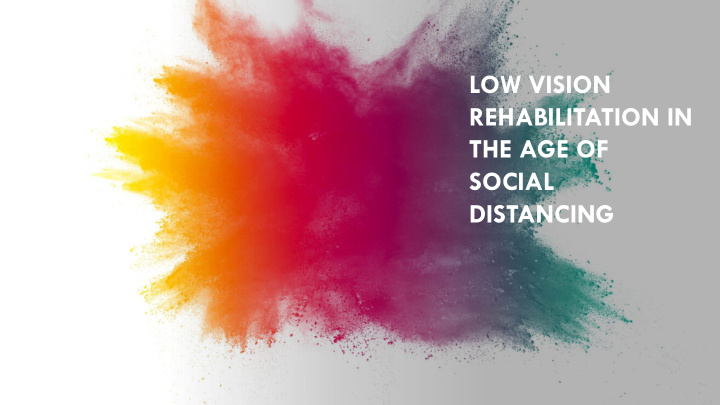



LOW VISION REHABILITATION IN THE AGE OF SOCIAL DISTANCING
David Lewerenz, OD, FAAO University of Colorado School of Medicine, Department of Ophthalmology Thank you to e-Sight for inviting me and thanks to everyone for attending I have no disclosures relevant to this presentation
During these pandemic times, we will go through at least three stages in caring for our patients/clients 1. Virtual health only 2. Limited and very cautious face-to-face visits 3. Resumption of normal scheduling and regular practices
Advantages of virtual health in low vision rehabilitation ▪ Safer for patient and provider during times of social distancing Many low vision patients (and providers) at risk of Covid-19 o complications ▪ Keeps patient and provider in touch and working on goals ▪ Some visual metrics can be accomplished o Visual acuity method demonstrated later
Challenges of virtual health visits in low vision rehabilitation ▪ Unable to do a refraction ▪ Unable to evaluate devices and most strategies ▪ Communication with patient is more limited Especially non-verbal communication o Less of an emotional connection o ▪ More difficult to collaborate with co-workers
Types of virtual health visits ▪ Phone calls Obviously lacks video element, but still very useful o I have recently guided patients on use of devices and strategies for o working on their goals ▪ Informal audio-video platforms FaceTime, Google Duo, Zoom are options o ▪ More formal and secure platforms o Linked through electronic medical records systems or patient portals o More secure, but also more complicated
Facilitating virtual health visits ▪ Introductory call by provider or staff member to make sure patient has the technology for the visit and knows how to use it ▪ Explain to the patient/client what can and can’t be accomplished ▪ Have a plan for recording findings Dual monitor is a big plus o
Types of visits best suited to virtual health ▪ Follow-up visits are by far the best ▪ Could use virtual health for history and to get ideas for what patient/client's struggles and goals are, so time is saved when a face-to-face visit is possible ▪ Any time a patient is having a problem or facing a new challenge o Encourage patients/clients to reach out to you if they are having difficulty
Limited and very cautious return to face-to-face care ▪ Precautions we’re taking – on the patient’s side o Pre-visit telephone screening: Exposure? Symptoms? Travel? Limited building access – initial check-in is done with patient still in o their vehicle Mask required o o No waiting rooms – patient escorted directly from entry to exam room o Limited accompaniment: No one <16 years old, not more than one, no recently exposed or symptomatic people allowed in building Checkout/next appointment done over phone in parking lot o
Limited and very cautious return to face-to-face ▪ Precautions we’re taking – on the provider’s side o Limited schedules Staggered schedules and considering split schedules o Mask worn (N-95 in low vision due to longer visits) o Gloves o o Room wipe-down following each appointment – then wait 10 minutes
Will the world be different after the coronavirus is defeated? ▪ Virtual health will likely continue at unprecedented levels o A virtual health follow up is much better than no follow up at all! ▪ Increased awareness of hygiene Medical visits o Social norms: Shaking hands? Hugging? o
Method of measuring visual acuity in a virtual health visit ▪ Challenges o If a chart to be printed is e-mailed to a patient, they may not have a printer o If a chart is used that appears on the patient’s screen, the size of the screen will determine the size of the optotypes ▪ Novel method described that takes into account the size of the patient’s screen and the distance from it
Thanks for your attention I’m very interested in your questions, comments and thoughts
Recommend
More recommend